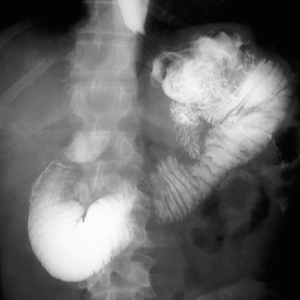GI Radiology > Stomach > Iatrogenic Problems
Iatrogenic Problems
![]()
Afferent Limb SyndromeAfferent limb syndrome (also called 'afferent loop syndrome') is a complication following Billroth II gastrojejunostomy characterized by acute or chronic intermittent obstruction of the afferent jejunal limb. Causes include jejunal herniation, intussusception, kinking, volvulus, marginal ulceration, para-anastomotic stenosis, and adhesion formation. Luminal dilatation occurs secondary to accumulation of biliary, pancreatic, and duodenal secretions. Clinical symptoms include postprandial fullness, abdominal pain, and bilious vomiting. Afferent limb perforation and the sequlae of biliary obstruction are the most common complications. Treatment depends upon the underlying etiology but often involves stenting or surgical revision. | |
|
UGIS Findings:
|
|
CT Findings:
|
|
Examination with water soluble contrast performed in a patient with repeated vomiting demonstrates Billroth II anatomy and preferential filling of the dilated afferent limb. The efferent limb is much more narrow, decompressed, does not fill with contrast--note the air filled lumen distally. (Image courtesy of Dr. Scott Wise; used with permission.) |
 |
